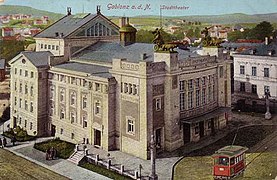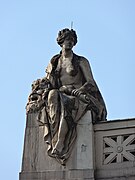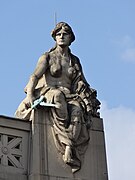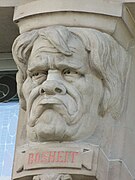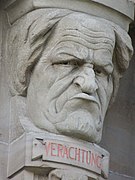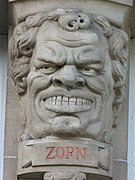City Theater Giessen
The Stadttheater Gießen on Berliner Platz in Gießen is a three-part house with a national presence, one of the cultural centers and one of six large subsidized theaters in Hesse . The free-standing classicist, but partly Art Nouveau- influenced building was built in 1907 by the architects Fellner & Helmer . On two stages and a total of 652 (Large House) and 99 (taT) seats, it offers a diverse repertoire of operas , musicals and operettas , classical and contemporary drama and modern dance theater . Cathérine Miville has been artistic director since the 2002/03 season .
history
A theater association was founded as early as 1890, and in 1903 it formed a theater union with the cities of Marburg and Bad Nauheim . As a result, a separate theater building became necessary, but this could not be implemented because the financial means were lacking. The city of Giessen agreed to make the property available free of charge. Thanks to a citizens' initiative, which on the occasion of the 300th anniversary of the University of Giessen in 1906, demanded a permanent theater venue and donated two thirds of the construction costs, the Giessen City Theater could be built for a total of 630,000 marks . Therefore, the inscription was placed above the portal: "A MONUMENT OF THE CIVIL COMMUNITY".
An architectural competition was launched that was open to all architects based in Gießen, but to which a number of foreign architects were invited: the four proven theater specialists Martin Dülfer (Munich), Bernhard Sehring (Berlin), Carl Moritz (Cologne) and Fellner & Helmer (Vienna), as well as the now forgotten Munich architect C. Tittrich . The design by the Viennese office Fellner & Helmer, which was created in collaboration with the Giessen architect Hans Meyer , was awarded a prize and was ultimately intended for implementation, with Hans Meyer being the site manager . In its Art Nouveau-influenced architecture, the building is similar to the Klagenfurt City Theater and the Gablonz City Theater (today: Jablonec nad Nisou) , which were also designed by Fellner and Helmer, except in terms of size, details and color . Since Hermann Helmer spoke out against secessionism , the typical Viennese variety of Art Nouveau, it is occasionally assumed in specialist literature on the history of architecture that these theaters were built by his son Hermann Helmer junior. who completed his architecture studies in Vienna in 1902 and then worked in his father's studio.
The theater was opened on July 27, 1907 with “The Prelude to the Theater” from Johann Wolfgang von Goethe's Faust , The Broken Jug by Heinrich von Kleist and Wallenstein's Lager by Friedrich Schiller . The first director was Hermann Steingoetter, who had been director in Gießen since 1903. In the first twenty years spoken theater dominated , which was expanded to music theater in 1932/1933 with its own orchestra .
On December 6, 1944, the auditorium fell victim to fire bombs . Because the financial means were lacking, the roof could only be repaired in a makeshift manner and it was not until six years later, in 1951, that complete renovation work was carried out with the help of a theater raffle . The auditorium, the foyer and the cash desk were renovated, but the historical style elements were lost during the work. The theater reopened on November 18, 1951 with Richard Wagner's Tannhäuser . Today the city theater is one of the few remaining pre-war buildings in downtown Giessen.
In 1978/1979 there was a further renovation, with the auditorium being converted into a rank theater. The foyer and the ticket hall were restored in their style. “In particular, the renewed Art Nouveau window front of the foyer from 1907 is to be emphasized”, writes a chronicler.
The last known renovation was in 1998, whereby the auditorium was equipped with an acoustic ceiling and new seating. In addition, the boxes on the 1st floor were reinstalled and the upper machinery and the Schnürboden were completely renovated.
architecture
location
The city theater is located on Berliner Platz. It stands on a corner lot and is a free-standing building. The theater borders the road network from the north to the south and a small park extends to the west.
Layout
The building has a symmetrical floor plan and its main entrance faces south. If you look at the individual parts of the room, it is noticeable that they overlap fluently, but that the various elements are clearly structured. The entrance leads to the foyer, from which two doors lead off on the right and left side. On the floor plan you can see that the two front rooms are only about half the size of the rear. From the foyer you can reach the centrally located hall building and its handling, which extends to the outer walls, via a few steps. This structure also forms the narrowest section of the theater. Also at the beginning of the hallway are the stairs to the upper tiers, on both sides, whereby this division corresponds to the "German type". The stage building and the ancillary stage rooms, which in turn are cut a little wider, extend behind the hall. The rear part of the building is formed by the back stage and depots. This is also the widest structure.
Architecture outside
If you look at the entire building, you can see how the interior is made up from the outside. The addition of the individual functional components inside determines the external appearance. The division is as follows: vestibule- foyer building, staircases, hall building, stage building, ancillary stage rooms, backstage and depots. The change between gable roof and hipped roof marks the individual structures again.
- Main facade
The outer facade is raised from the rest of the sand-colored plastered wall with "a base cornice made of Ettringer tuff stone ". The three large, dark brown entrance portals , which are located on the protruding front facade, can be reached via a few steps from the forecourt. They are covered with a glass roof. Six long, narrow Art Nouveau windows, framed in white and decorated with colored glass, extend along the front of the vestibule. Between the windows and finally to the right and left, there are narrow pillars that end at the top with seven different allegorical representations. Including the allegorical depictions of malice, scorn, lust, satyr, contempt, wit and anger. Above it is the inscription "A monument to common sense". The facade is completed with two corner sculptures, an " Attica with decorative stone grids" and another inscription in the middle. The two figures are the statue of Thalia , muse of comedy on the left, and the statue of Melpomene , muse of tragedy on the right. Between the two you can find the saying of Friedrich Schiller : "Because out of the beautifully united striving does real life arise".
- Allegorical representations on the facade
In addition to the main facade, there are two balcony stairs to the side of the vestibule and two side extensions with decorative friezes. History, war, rhetoric, art and science can be seen on the right frieze and dance, wine, music and love on the left.
The theater is only designed a bit more elaborately on the front facade with sculptures, decorations and inscriptions. The side facades, on the other hand, are kept very simple and more classical. The stage tower, which extends above the stage building, has six lancet-shaped windows that rise up into the gable, thus repeating the front motif. The two longitudinally aligned roofs of the stage tower and hall structure give the building a corresponding direction. In summary, the exterior of the city theater forms a good mix of classicist and art nouveau.
Architecture inside
“The architecture inside is freely developed, and all motifs taken from antiquity are adapted to the modern design language. The vestibule with a coffered ceiling , stucco division on the walls, a red marble plinth , yellow marble steps, a Roman tiled floor and swing doors with faceted brass puts the visitor in the mood for his visit to the theater. From here, visitors can get directly to the parquet seats, while visitors are led to the 1st and 2nd tier via stairways arranged on both sides. An Art Nouveau foyer is located in the first tier. The pillars between the foyer and the walkway were made of finely polished artificial marble in the color of 'vert antique' and were redesigned when the original condition was restored in 1979. When the theater was completed, the auditorium was free of any overload. The white ceiling was adorned with ornaments set in gold and stood in contrast to the rich red of the walls and the theater armchairs covered with red pergamoid. Overall, the auditorium made an elegant impression with its 600 seats. The stage equipment corresponded to the standard at that time. The signal boxes were among the most modern in Germany. They enabled drama , opera and operetta performances to be carried out . The orchestra pit was designed in such a way that it could be raised for theater or concert performances and increased the stage area. "
Stylistic classification
The theater in Gießen, which originated from the architects Fellner & Helmer, was the first to be based on Art Nouveau. The architecture forms a simple and at the same time strict form. The change from simple, classicist style elements to the decorative design language of Art Nouveau, which despite decorations and various ornaments does not give up its "principle of formalism ", creates a harmonious appearance. The actual Art Nouveau elements are mainly reflected in the stained glass windows, which express the geometric direction of Art Nouveau. Furthermore, the style can be seen in the attic, which reflects the floral direction, and also in the corner sculptures on the front facade.
structure
Today the repertoire of the city theater offers a diverse range in all areas. Ten symphony concerts per season as well as a series of chamber concerts and soloist portraits are very popular with music lovers in the region. The program is supplemented by introductory events for the individual productions as well as readings and discussions that take place regularly in the Art Nouveau foyer.
In addition to the large house with its 600 seats, the taT studio stage has been a second venue with around 99 seats since September 2014, the focus of which is on contemporary pieces from all branches. The taT follows the Theater im Löbershof (TiL) and the cigar factory , which served as second venues after or before 1991. With the aim of showing lively contemporary theater, the TiL, then the taT (Theater am Theater), was able to develop a clear profile that is enjoying great and steadily growing acceptance among the Giessen public.
Children's and youth theater can be seen all year round at the Giessen City Theater with productions for different age groups in the large house and in the taT. A moderated series of concerts for schoolchildren with the in-house Philharmonic Orchestra is also aimed at the young audience. In the junior and youth club, children and young people are invited to take part. The municipal theater's children's and youth choir has also become a permanent fixture.
More than 250 employees work at the Stadttheater Gießen in around 50 different professions. In addition to its in-house productions, the city theater maintains co-productions with other theaters, with the universities in Frankfurt, Gießen and the Hochschule für Gestaltung in Offenbach am Main within the framework of the Hessian Theater Academy as well as with the organizers and associations of the city of Gießen . Partnerships with the Darmstadt State Theater , opera and drama Frankfurt , the City Theater Heidelberg , the Mannheim National Theater , the State Theater of Kassel , the Mainz State Theater , the Hessian State Theater in Wiesbaden and the Hesse State Theater Marburg . From the 2014/15 season, the theater also began collaborations with the independent scene, also and above all with the Institute for Applied Theater Studies at Giessen University.
Since the 2002/03 season, Cathérine Miville has been the artistic director and managing director of Stadttheater Gießen GmbH .
Opera rarities
At the end of the 1970s there was a close collaboration between the Stadttheater Gießen and the composer Gian Carlo Menotti , who staged a number of his operas himself: The Consul (1978/79), La Loca - Johanna die Wahnsinnige (European EA 1980/81), Das Medium (1983/84), Maria Golovin (1985/86), Amelia goes to the ball (1987/88), Help! Help! The Globolinks (1998/99).
For many years, the Stadttheater Gießen has also stood out for its productions of operas, some of which have been completely forgotten in Germany, as well as numerous first performances. These include u. a. Scott Joplin : Treemonisha (European EA 1983/84), Stanislaw Moniuszko : Halka (1992/93), John Philip Sousa : Der Feldhauptmann (European EA 1995/96), Manfred Gurlitt : Wozzeck (1997/98), Louis Spohr : Faust (1999/2000), Max Brand : Machinist Hopkins (1999/2000), Heinrich Marschner : Der Templer und die Jüdin (2000/01), Leoš Janáček : Š arka (2000/01), Alfred Bruneau : L'attaque du moulin (German EA 2001/02), Ferdinand Herold : Zampa (2004/05), Saverio Mercadante : Il Giuramento (2006/07), Ethel Smyth : Strandräuber (2006/07), Carlos Gomes : Lo Schiavo (German EA 2010/11 ), Friedrich von Flotow : Alessandro Stradella (2011/12), Giovanni Pacini : Maria Tudor (German EA 2011/12), Carlos Gomes : Fosca (German EA 2012/13), Emilio Arrieta : Die Eroberung von Granada (German EA 2013 / 14), Gaetano Donizetti : Linda di Chamonix (2014/15), Ernst Krenek : Kehraus um St. Stephan (German EA 2014/15), François-Adrien Boieldieu : The White Lady (2015/16), Emmerich Kálmán : Operetta E. in Herbstmanöver (2017/18, also CD production), Umberto Giordano : Mala vita (2018/19) and the world premiere of Alp Arslan by Richard van Schoor (2018/19).
management
Directors
Hermann Steingoetter (1907–1928), Rudolf Prasch (1928–1933), Hanns König (1933–1935), Hermann Schultze-Griesheim (1935–1941), Hannes Razum (1941), Hans Walter Klein (1941–1943), Anton Ludwig (1943–1945), Kurt Sauerland (1945–1946), Gerd Bries (1946–1948), Adolf Rampelmann (1948–1949), Kurt Sauerland (1949–1950), Anton Ludwig (1950–1954), Friedrich Brandenburg ( 1954–1958), Wolf Dietrich von Winterfeld (1958–1963), Willi Kowalk (1963–1966), Dietrich Taube (1966–1978), Reinald Heissler-Remy (1978–1988), Jost Miehlbradt (1988–1993), Robert Tannenbaum (1993–1996), Guy Montavon (1996–2002), Cathérine Miville (since 2002)
General Music Directors
Fritz Cujé (1933–1935), Paul Walter (1935–1940), Otto Söllner (1940–1944), Karl-Heinz Eckert (1946–1948), Willy Czernik (1948–1954), Emil Häusler (1954–1957), Wolf Dietrich v. Winterfeld (1957–1963), Rudolf Sailer (1963–1965), Gerd Heidger (1965–1991), David de Villiers (1991–1997), Michael Hofstetter (1997–1999), Herbert Gietzen (acting 1999–2000), Stefan Malzew (2000–2002), Herbert Gietzen (acting 2002–2003), Carlos Spierer (2003–2011), Michael Hofstetter (2012–2019), Florian Ludwig (since 2020)
Division management
Under the management of Cathérine Miville, Tarek Assam has been head of the dance theater division since 2002, Abdul-M. Kunze has headed the children's and youth theater since 2002 and Florian Ludwig has been general music director for the 2020/21 and 2021/22 seasons. The acting division is under a shared management, led by Miville, Björn Mehlig, Carola Schiefke and Harald Wolff since the 2018/19 season. Moritz Gogg is the artistic director and deputy to the artistic director .
literature
- Dieter Zöchling: Opera houses in Germany, Austria and Switzerland. History, events, performers . Düsseldorf 1983, ISBN 3-612-10023-8 .
- Hans-Christoph Hoffmann: The theater buildings by Fellner and Helmer . Munich 1966, ISBN 3-7913-0128-4 .
- Hans Meyer (Ed.): The new city theater in Gießen. Memorandum to celebrate the opening . Roth, Giessen n.d. [1907].
- Jo Straeten u. a .: City Theater Giessen. Festschrift for the 75th anniversary . City Theater Giessen, Giessen 1982.
- Jost Hermand (ed.): Art Nouveau . Darmstadt 1992, ISBN 3-534-03463-5 .
- Literature about Stadttheater Gießen in the Hessian Bibliography
- Magistrate of the university town of Giessen (ed.): [Ludwig Brake, Eckhard Ehlers, Friedhelm Häring]: Theater in front of the theater; on the history of theater in Giessen . Booklet accompanying the exhibition from May 11th to June 6th 2007 in the Stadttheater Gießen, self-published by Stadt Gießen, Gießen 2007.
- Manfred Godehardt: Gießen 2007 - A building culture anniversary year (2) - 100 years of the Stadttheater Gießen , 13 August 2012
- Stadttheater Gießen (Hrsg.): 100 years Stadttheater Gießen . Self-published, Giessen 2007. ISBN 978-3-9811711-5-0 .
Web links
- Official website
- State Office for Monument Preservation Hessen (Hrsg.): Stadttheater Gießen In: DenkXweb, online edition of cultural monuments in Hessen
Individual evidence
- ↑ a b c d e f Hoffmann 1966, p. 98.
- ↑ Hoffmann 1966, p. 97.
-
↑ Deutsche Bauzeitung , Volume 39, 1905, No. 26 (of March 31, 1905), p. 164. (Note on the competition announcement)
C. Tittrich is only mentioned a few times in the architectural history literature, neither biographical details nor a special one Tittrich's relation to the theater building or to the city of Giessen is known so far. - ↑ Deutsche Bauzeitung , Volume 39, 1905, No. 41 (from May 24, 1905), p. 252. (Note on the competition result; mention of the collaboration between Fellner and Helmer with Meyer)
- ↑ Hoffmann 1966, p. 46.
- ↑ a b Zöchling 1983, p. 127.
- ↑ Zöchling 1983, pp. 125/126.
- ↑ Zöchling 1983, pp. 125-127.
- ↑ a b c d e Gießen 2007 - A building culture anniversary year (2) , Association of German Architects and Engineers Associations eV, (June 21, 2012).
- ↑ Hoffmann 1966, p. 45.
- ↑ Hoffmann 1966, p. 60.
- ↑ Hermand 1992, p. 71.
- ^ Stadttheater Gießen (Ed.): 75 years of the Philharmonic Orchestra Gießen . Giessen September 2008.
Coordinates: 50 ° 35 ′ 2.6 ″ N , 8 ° 40 ′ 39.7 ″ E




